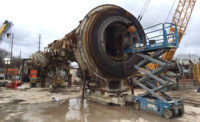
Kris Kyler recognizes that his small heating, ventilating and air-conditioning business operates in the sustainability space, but he freely admits that he isn't a poster child for clean air, soy burgers and farm shares. "I wouldn't really call myself a tree hugger," says Kyler, an avid off-roader and motorcycle racer. "We're doing these things because they make sense, and they are good business."
Kyler, the president of Indiana Geothermal Inc., Indianapolis, doesn't walk or talk like a slick salesman. He speaks about technology in terms of dollars and cents, and the Indianapolis-area native dresses to match his unassuming roots: a generic running jacket, blue jeans and tennis shoes. He drives a blue Ford F-250 pickup—it runs on compressed natural gas—decked out in chrome trim and leather seats. It doesn't take long to discover, however, that he is a quick study at the alternative-energy business.
The market for geothermal heating and cooling, a technology that is more than 50 years old, is gaining acceptance worldwide as architects, engineers and building owners recognize it as a means to keep rising energy costs in check while racking up green checklist points. According to ClimateMaster, a supplier of ground- and water-source heat pumps, geothermal systems are 400% to 600% efficient, compared to gas-fired furnaces, which are only 98% efficient.
Indiana Geothermal capitalizes on the numbers by going where many heating contractors fear to tread—underground. As a contractor, the company focuses tightly on the installation of the high-density polyethylene piping to support heat pumps. A ClimateMaster wholesale distributor, it sells the rest of the equipment as a package deal, but it does not perform the build-out of the fan units, duct work or other "inside" jobs.
"Most heating contractors don't have backhoes," Kyler explains. "They are sheet-metal guys. It is actually somewhat insulting to a service technician to ask him to get into a ditch and install pipe."
Kyler, 49, would know, as he has spent the last 30 years working in the mechanical field. In 1982 he completed a one-year tech-school certification and went to work for a contractor that specialized in putting up solar panels. Tax credits soon dried up, and the company shifted to geothermal. Kyler became hooked on energy-efficient HVAC, but his boss soon went bankrupt. In 1989 he opened a family business, Kyler Bros. Heating and Cooling, a full-service contractor.
"It slowly grew, and we were up to the point where we were doing about $9 million a year total," Kyler says. In 2007 he sold the company but retained the ground-loop installation business, which became Indiana Geothermal. The company now books about the same annual revenue as Kyler Bros. when it was sold but with a third of the work force. About 80% of the business is loop installs, with the wholesale side taking up the balance. The company targets a net operating margin of 10%—which many contractors would welcome—though the year-end totals typically end up settling in the high single digits, Kyler says.
As a small business owner, Kyler likes the agility that comes with an operation of just 20 employees. Employees are loyal, too. The running joke around the office is that people need to screw up royally to get fired. For example, one installer couldn't get on the company insurance because of his poor driving record, so Kyler assigned a permanent driver to him.
"For the average company, he is probably unemployable," Kyler says. "Once you've got a guy who is halfway trained, usually it is easier to fix them than it is to just find somebody else. We'll go to some pretty great efforts to bring somebody along." As a businessman, Kyler is "the most reasonable person I have come across," adds Jay Trout, an independent HVAC salesman who reps geothermal contractors and suppliers from Maple Park, Ill. "He has a really good temperament."
Indiana Geothermal weathered the recession by picking up higher volumes of building retrofits as the new-housing boom went bust. Tax credits in the 2009 federal stimulus package, which recognized geothermal as a renewable energy, helped spur demand. The company also performs large commercial jobs, having this spring installed a 700-ton lake loop at Chicago's 31st Street Harbor and a new marina on Lake Michigan worth $85 million, recognized as one of ENR Midwest magazine's best projects of 2012.
Compressed natural gas, which some see as a clean and abundant energy source, is Kyler's latest kick. At the time he sold his former business, he picked up federal, state and local grants worth $260,000 to build a CNG filling station that normally would have cost $340,000, requiring an up-front investment of just $80,000. The grants required that the station be made public, something Kyler was not excited about.
"I didn't want to be open to the public," he explains. "I wanted to put it in for my own fleet." As a stroke of luck, AT&T converted some of its local fleet to CNG, and Kyler now gets 75 AT&T vans per day filling up at his station as well as other "transient" traffic. For his company's use alone, Kyler estimated a five-year payback in the difference between the cost of gasoline and CNG. It now is a profit center with a net margin of about 20%. Six months ago, the company began offering a new service to convert vehicles to run on CNG, and it plans to open two more stations.
Although the CNG business is threatened by the alternative fuel's own potential mainstream adoption—Kyler admits that he couldn't compete with convenience store chains—he still sees a 10-year opportunity to make money. Before then, he'll likely be onto another clean-energy venture. "I'm very open-minded to anything," he says, "but it's got to make sense."





